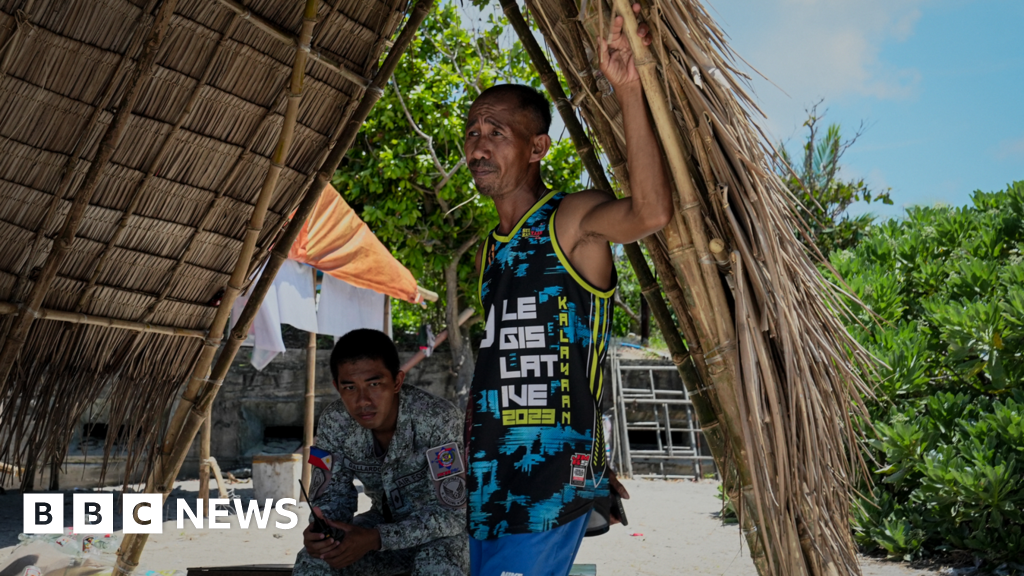The Resilient Community of Pagasa Island: Standing Firm Against Chinese Aggression












2025-05-20T21:03:39Z

An island known as Pagasa, translating to "hope" in Filipino, is making headlines for its staunch resistance against China's encroachment in the South China Sea. Despite its modest size of just 37 hectares, Pagasa is more than just a dot on the map; it is a vibrant community that boasts around 300 residents living in small, wooden houses.
These residents sustain themselves through fishing in the crystal-clear turquoise waters and cultivating whatever vegetables they can in the sandy soil. Yet, they are not alone in these contested waters. Just offshore to the west lies a significant fleet of Chinese vessels, comprising naval ships, coastguard patrols, and a so-called maritime militia, which includes large fishing trawlers repurposed to maintain China's dominance in the region. Upon approaching the island by air, our flight spotted at least 20 such ships, a reminder of the ongoing tensions in these waters.
For over a decade now, China has systematically increased its presence in the South China Sea. It has militarized submerged coral reefs, constructing three substantial airbases, and deployed a formidable number of vessels to reinforce its claim over nearly the entire region, which holds critical shipping lanes connecting some of China's most essential export hubs. While several Southeast Asian countries also assert their claims over islands in this sea, only the Philippines and Vietnam have dared to push back against Chinese expansion. Both countries have military forces that are significantly smaller than China's, yet they manage to hold on to a handful of reefs and islands, with Pagasa being the largest among them.
What sets Pagasa apart is its civilian population, which is not found on any other island in the South China Sea. The Philippines views this populated status, along with the solid land of Pagasa as opposed to a mere submerged reef, as bolstering its legal claims in the area. Jonathan Malaya, the assistant director-general of the Philippines National Security Council, emphasized Pagasa's significance, stating, "Pagasa is very important to us. It has a runway. It can support life – it has a resident Filipino community, and fishermen living there." He elaborated that because of its size, Pagasa generates its own territorial sea of 12 nautical miles under international law, making it a pivotal point for the Philippines’ presence in the region.
Accessing Pagasa is no simple task. It requires a two-to-three-day boat ride from Palawan or a one-hour flight, both of which are at the mercy of the region's notoriously fickle weather. In a bid to improve connectivity, the Philippine government resurfaced and extended the island's runway to 1,300 meters (4,600 feet) two years ago, allowing larger C130 transport aircraft to land. The plane ride resembles a packed bus during rush hour, filled with supplies from the mainland, including mattresses, bags of rice, and even motorbikes, alongside military personnel, many of whom stood for the duration of the flight.
Significant changes have taken place on Pagasa in recent years; a new hangar was constructed to protect aircraft during storms, and a control tower is currently under construction. In addition, dredging is underway to create a small harbor for larger boats to dock. During our visit, we were escorted around the island by Philippine marines stationed there, though given the island's size, their presence seemed more symbolic than strategic.
Pagasa has a complex history, having been seized from Taiwan in 1971 when the Taiwanese garrison abandoned it during a typhoon. The Philippines formally annexed it in 1978, subsequently encouraging civilians to settle on the island. However, life remains challenging. The government provides families with monthly supplies of food, water, and groceries. Electricity and mobile connectivity were only introduced four years ago, and outside of government employment, fishing remains the primary livelihood. Yet, the presence of Chinese vessels has made fishing increasingly difficult, leading many local fishermen, like Larry Hugo, to remain closer to shore, depleting local fish stocks. Hugo has lived on Pagasa for 16 years and documented the growing Chinese control in the area, gaining a measure of fame after posting a video in which a Chinese coastguard ship nearly collided with his small boat.
On the island, the local school has grown from a tiny hut to a full-sized institution serving over 100 students ranging from kindergarten to 18 years old, according to Realyn Limbo, a teacher who has worked there for a decade. She describes Pagasa as a paradise, where essential needs are met, and life is peaceful. "The children can play basketball or go swimming after school. We don't need shopping malls or all that materialism," she stated.
While the island has a serene charm, it also carries the weight of its unique status as a garrison community. In the sweltering midday heat, it is common to see residents napping in hammocks or enjoying music on their porches. Health worker Melania Alojado shared her insights, noting that the biggest challenge arises when residents become ill, especially children. "If it is serious, then we need to evacuate them to the mainland. I am not a registered nurse, so I cannot perform complicated medical tasks. But planes are not always available, and sometimes the weather is too rough to travel. When that happens, we just have to care for them as best we can." The situation on Pagasa highlights the resilience of its inhabitants as they navigate the complexities of life in a contested region, maintaining hope in the face of adversity.
 Angela Thompson
Angela Thompson
Source of the news: BBC